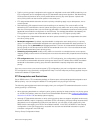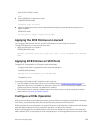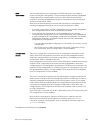
• The DCBx port-role configurations determine the ETS operational parameters (refer to Configure a
DCBx Operation).
• ETS configurations received from TLVs from a peer are validated.
• If there is a hardware limitation or TLV error:
– DCBx operation on an ETS port goes down.
– New ETS configurations are ignored and existing ETS configurations are reset to the default ETS
settings.
• ETS operates with legacy DCBx versions as follows:
– In the CEE version, the priority group/traffic class group (TCG) ID 15 represents a non-ETS priority
group. Any priority group configured with a scheduler type is treated as a strict-priority group and
is given the priority-group (TCG) ID 15.
– The CIN version supports two types of strict-priority scheduling:
* Group strict priority: Use this to increase its bandwidth usage to the bandwidth total of the
priority group and allow a single priority flow in a priority group. A single flow in a group can
use all the bandwidth allocated to the group.
* Link strict priority: Use this to increase to the maximum link bandwidth and allow a flow in any
priority group.
CIN supports only the dot1p priority-queue assignment in a priority group. To configure a dot1p
priority flow in a priority group to operate with link strict priority, you configure: The dot1p priority for
strict-priority scheduling (strict-priority command). The priority group for strict-priority
scheduling (scheduler strict command.
Configuring Bandwidth Allocation for DCBx CIN
After you apply an ETS output policy to an interface, if the DCBx version used in your data center network
is CIN, you may need to configure a QoS output policy to overwrite the default CIN bandwidth allocation.
This default setting divides the bandwidth allocated to each port queue equally between the dot1p
priority traffic assigned to the queue.
To create a QoS output policy that allocates different amounts of bandwidth to the different traffic types/
dot1p priorities assigned to a queue and apply the output policy to the interface, follow these steps.
1. Create a QoS output policy.
CONFIGURATION mode
qos-policy-output output-policy-name
The maximum 32 alphanumeric characters.
2. Configure the percentage of bandwidth to allocate to the dot1p priority/queue traffic in the
associated L2 class map.
QoS OUTPUT POLICY mode
bandwidth-percentage percentage
The default is none.
3. Repeat Step 2 to configure bandwidth percentages for other priority queues on the port.
QoS OUTPUT POLICY mode
bandwidth-percentage percentage
4. Exit QoS Output Policy Configuration mode.
258
Data Center Bridging (DCB)


















